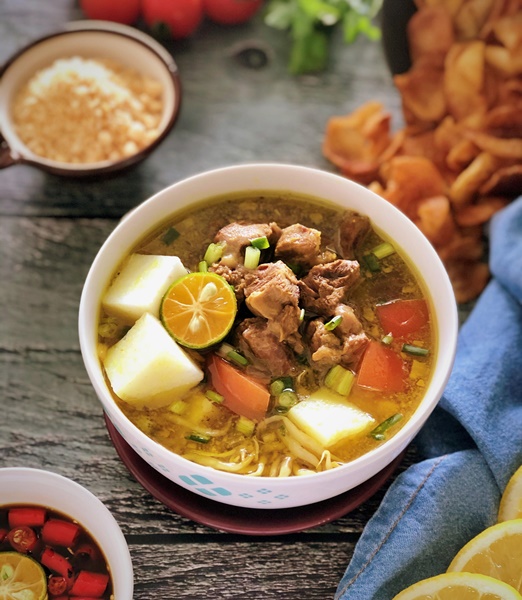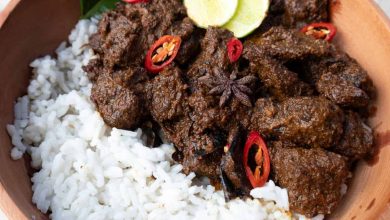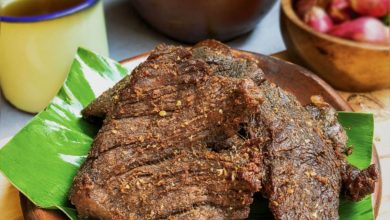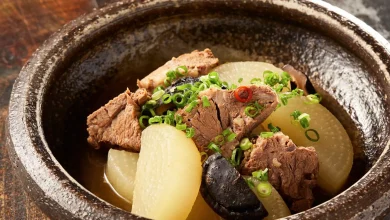Introduction
Soto Sapi is a traditional Indonesian beef soup renowned for its rich aroma, complex flavors, and hearty ingredients. Originating from the diverse culinary landscape of Indonesia, Soto Sapi has carved out its place as a beloved comfort food, especially during cooler weather or family gatherings. Its fragrant broth, tender beef, and fresh vegetables make it an ideal dish for those seeking a flavorful and nourishing experience. The dish combines aromatic spices, fresh herbs, and a variety of textures to create a symphony of taste that is both satisfying and revitalizing.
At Love With Recipes, our mission is to provide detailed, high-quality recipes that help you recreate authentic dishes with ease and confidence. This Soto Sapi recipe has been meticulously crafted to guide you through each step, ensuring that you achieve a flavorful, aromatic, and perfectly cooked dish every time. Whether you’re an experienced home cook or a beginner eager to explore Indonesian cuisine, this comprehensive guide will serve as your ultimate resource for mastering Soto Sapi.
Time
Preparation Time: 30 minutes
Cooking Time: 1 hour 30 minutes
Total Time Required: approximately 2 hours
Needed Equipment
- Large stockpot or Dutch oven
- Blender or food processor
- Knife and cutting board
- Measuring spoons and cups
- Soup ladle
- Small skillet (optional, for frying shallots)
- Strainer or sieve (for rinsing noodles and vegetables)
- Serving bowls
- Stove or cooktop
Tags
Indonesian Cuisine, Beef Soup, Comfort Food, Aromatic Soup, Traditional Recipe, Hearty Meal, Spicy Broth, Family Favorite
Serving Size
Serves 4-6 people, depending on portion size
Difficulty Level
Intermediate — requires some familiarity with handling spices and simmering meat until tender
Allergen Information
- Nuts: Candlenuts (used as a thickening agent and flavor enhancer)
- Gluten: Present if rice noodles contain gluten (check packaging)
- Potential cross-contact with shellfish or other allergens depending on ingredients used in spice paste (if store-bought paste is used)
Dietary Preference
Gluten-Free: Yes (if rice noodles are gluten-free)
Vegetarian/Vegan: Not suitable due to beef content
Keto-Friendly: Moderate, depending on portion size and ingredients
Course
Main Course / Soup
Cuisine
Indonesian
Ingredients
Meat and Vegetables
| Ingredient | Quantity | Notes |
|---|---|---|
| Mixed beef cuts (sirloin, brisket) | 2 ounces (about 60 grams) | Cut into bite-sized cubes |
| Bean sprouts (tauge) | To taste | Rinsed and drained |
| Rice noodles (bihun) | 200 grams (about 7 oz) | Soaked in warm water before serving |
| Green onions (daun bawang) | 2 stalks | Sliced thinly |
| Tomatoes | 2 medium | Diced |
| Fresh celery leaves (seledri) | A handful | For garnish |
| Fried shallots (bawang goreng) | As garnish | Prepared separately |
| Water | As needed | For broth |
Spice Paste Ingredients
| Ingredient | Quantity | Preparation |
|---|---|---|
| Bay leaves (daun salam) | 2 leaves | Whole |
| Lemongrass (sere) | 2 stalks | Bruised |
| Kaffir lime leaves (jeruk wangi) | 2 leaves | Whole or torn |
| Garlic | 4 cloves | Peeled |
| Shallots | 5 | Peeled |
| Black pepper | 1 teaspoon | Whole or ground |
| Ginger | 1-inch piece | Peeled |
| Turmeric | 1-inch piece | Peeled |
| Galangal | 1-inch piece | Peeled |
| Cloves | 2 | |
| Candlenuts (kemiri) | 3 | Peeled |
| Salt | To taste | For seasoning |
Instructions
1. Preparing the Beef
Begin by selecting fresh, high-quality beef cuts suitable for slow cooking. The preferred cuts are sirloin and brisket because they become tender and flavorful after simmering. Rinse the beef thoroughly under cold running water to remove any blood or impurities. Using a sharp knife and a clean cutting board, cut the beef into bite-sized cubes approximately 1 to 1.5 inches in size. Uniform pieces help ensure even cooking and tender results. Once cut, set aside.
It’s beneficial to remove excess fat from the beef to avoid overly greasy broth, but retain some marbling for richer flavor. You might also choose to marinate the beef briefly with a little salt and pepper to enhance flavor before cooking.
2. Making the Spice Paste
The spice paste forms the aromatic backbone of Soto Sapi. To prepare it, gather all the ingredients listed under the spice paste section. For convenience and better blending, peel the garlic, shallots, ginger, turmeric, galangal, and candlenuts. Using a blender or food processor, combine the garlic, shallots, black pepper, ginger, turmeric, galangal, cloves, and candlenuts. Blend until you achieve a smooth, homogeneous paste, adding a little water or oil if necessary to facilitate blending.
If you prefer a more traditional approach, you can grind these ingredients using a mortar and pestle, which imparts a slightly different texture and flavor profile.
3. Cooking the Spice Paste
In a large, heavy-bottomed stockpot or Dutch oven, heat about 2 tablespoons of vegetable oil over medium heat. Once hot, add the blended spice paste. Sauté the paste, stirring constantly, for approximately 5-7 minutes until fragrant and slightly darkened. This process releases essential oils and intensifies the aroma of the spices, building the foundation of flavor for the broth.
Next, add the bay leaves, bruised lemongrass stalks, and kaffir lime leaves to the pot. Stir them into the spice paste and cook for another 2-3 minutes to allow the flavors to meld. Be cautious not to burn the spices; adjust the heat as needed to prevent sticking or scorching.
4. Simmering the Broth and Beef
Pour enough water into the pot to fully cover the beef and spices—typically about 6 to 8 cups, depending on the desired soup volume. Increase the heat to high and bring the mixture to a vigorous boil. As the water heats, use a spoon to skim off any foam or impurities that rise to the surface, ensuring a clear broth.
Add the prepared beef cubes into the boiling broth. Reduce the heat to low and cover the pot with a lid. Allow the beef to simmer gently for approximately 1 to 1.5 hours, or until the meat is tender and easily shredded with a fork. During cooking, occasionally check the broth and add more hot water if necessary to keep the beef submerged and to maintain the desired richness.
Cooking the beef slowly over low heat ensures it becomes tender and absorbs the flavors of the spices, resulting in a flavorful, melt-in-your-mouth texture.
5. Finishing the Soup
Once the beef reaches the desired tenderness, add the diced tomatoes to the broth. Tomatoes introduce acidity and brightness, balancing the richness of the beef and spices. Allow the tomatoes to soften and release their juices, about 5-8 minutes.
Stir in the sliced green onions, reserving some for garnish if desired. Continue cooking for another 5–10 minutes to develop a harmonious flavor profile. Taste the broth and season with salt as needed. Remember that the spice paste and beef already contribute saltiness, so adjust cautiously.
Remove the bay leaves, lemongrass stalks, and kaffir lime leaves before serving. These ingredients impart strong flavors but are not meant to be eaten directly.
6. Preparing Noodles and Garnishes
While the broth simmers, prepare the rice noodles. Place the bihun in a bowl of warm water to soak for approximately 10-15 minutes until soft. Drain and set aside. You can also cook the noodles briefly in boiling water if preferred, but soaking preserves their texture and flavor.
Fry shallots until golden brown and crispy, either in a small skillet with a little oil or in a deep fryer. Drain on paper towels and set aside for garnishing.
Arrange bean sprouts, fresh celery leaves, and sliced green onions for serving. These fresh toppings add crunch, brightness, and herbal notes that contrast beautifully with the warm broth and tender beef.
Preparation Tips
- Use high-quality, fresh beef for best results. Marinate the beef with a pinch of salt and pepper for added flavor.
- For a more intense spice flavor, toast the candlenuts and cloves lightly before blending to release their essential oils.
- If you prefer a milder broth, reduce the amount of black pepper or omit the candlenuts.
- Adjust the cooking time based on the cut of beef used; tougher cuts require longer simmering for tenderness.
- For a clearer broth, skim off foam and impurities frequently during boiling.
- Feel free to customize toppings—hard-boiled eggs, lime wedges, or chili sauce can elevate the dish further.
Nutritional Information
| Nutrient | Per Serving (approximate) |
|---|---|
| Calories | 350 kcal |
| Protein | 25 grams |
| Fat | 12 grams |
| Carbohydrates | 40 grams |
| Fiber | 4 grams |
| Sugar | 5 grams |
| Sodium | 900 mg |
Tips and Tricks
- For an extra depth of flavor, add a splash of fish sauce or soy sauce during seasoning.
- Use a slow cooker for hands-off simmering, especially if you prefer a set-it-and-forget-it approach.
- To intensify the broth, simmer uncovered for an additional 15-20 minutes to reduce and concentrate flavors.
- Leftover broth can be stored in airtight containers in the refrigerator for up to 3 days or frozen for longer storage.
- Reheat gently to preserve the tender beef and fresh vegetable textures.
Add-ons
- Hard-boiled eggs, sliced
- Chili sauce or sliced fresh chilies for heat
- Lime wedges for added acidity
- Additional fresh herbs such as cilantro or basil
Side Dishes
- Steamed rice or Indonesian-style rice cakes
- Fried tofu or tempeh
- Selada (Indonesian salad with shredded vegetables and peanut sauce)
- Kerupuk (Indonesian crispy crackers)
Improvements
- Use homemade stock for an even richer, more flavorful broth.
- Experiment with different spice combinations, such as adding turmeric or coriander for variation.
- Include additional vegetables like carrots or potatoes for a more substantial meal.
- Adjust the spice paste ingredients to cater to personal heat preferences.
Save and Store
Allow the soup to cool to room temperature before transferring to airtight containers. Store in the refrigerator for up to 3 days. For longer storage, freeze in portions for up to 1 month. To reheat, gently warm on the stovetop, adding a splash of water or broth if necessary to restore the consistency.
FAQ
Can I make Soto Sapi vegetarian?
Traditional Soto Sapi is beef-based, but for a vegetarian version, substitute the beef with hearty vegetables like mushrooms or tofu. Use vegetable broth infused with similar spices for flavor.
Can I use store-bought spice paste?
Yes, pre-made Indonesian spice pastes are available at Asian markets and can save time. Choose a high-quality product for authentic flavor, and adjust seasoning as needed.
What is the best type of beef for this soup?
Choose cuts with good marbling for tenderness, such as sirloin or brisket. These cuts benefit from slow simmering, becoming melt-in-your-mouth tender.
How do I make fried shallots?
Thinly slice shallots and fry in hot oil until golden brown and crispy. Drain on paper towels to remove excess oil. Store in an airtight container for future use.
Conclusion
Mastering Soto Sapi at home offers an authentic taste of Indonesian culinary tradition, rich in aroma and flavor. This comprehensive guide from Love With Recipes ensures you understand each step, ingredient, and technique necessary to craft a bowl of soulful, aromatic beef soup. Whether served as a main course for family dinners or a special dish for gatherings, Soto Sapi promises to bring warmth, comfort, and a touch of Indonesia’s vibrant cuisine to your table. With patience and attention to detail, you can recreate this beloved dish and delight your family and friends with an unforgettable culinary experience.
References
- Indonesian Food & Cookery by Nyonya Su Min Lim
- Authentic Indonesian Recipes from the Culinary Institute of Indonesia







